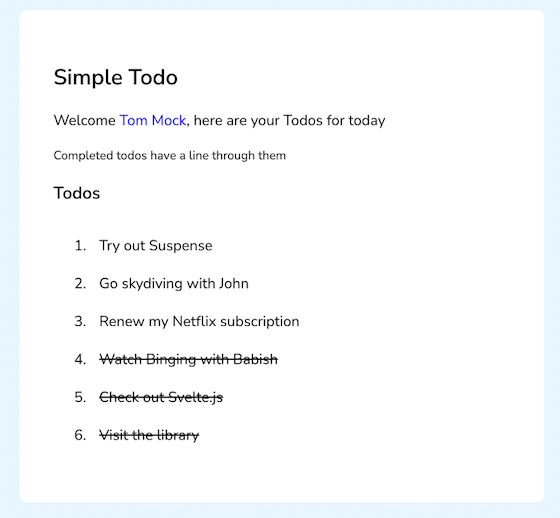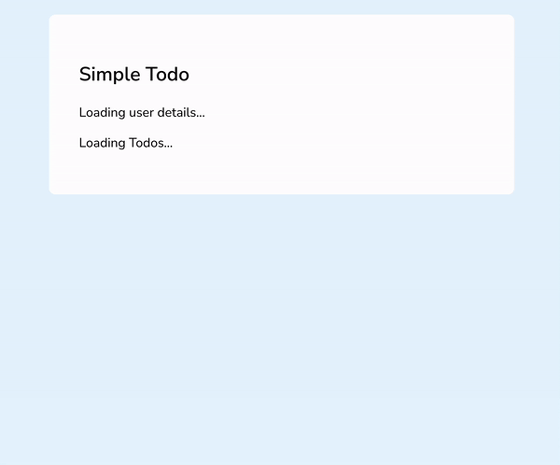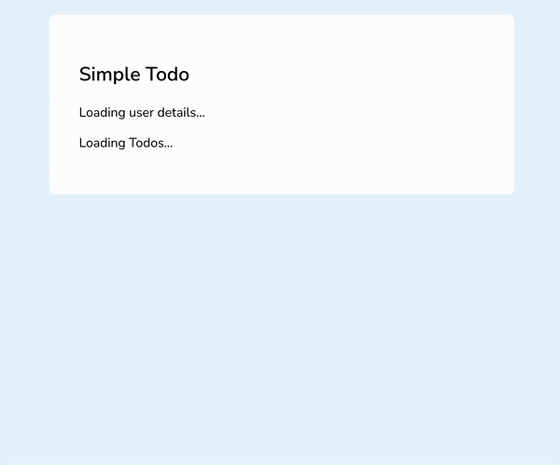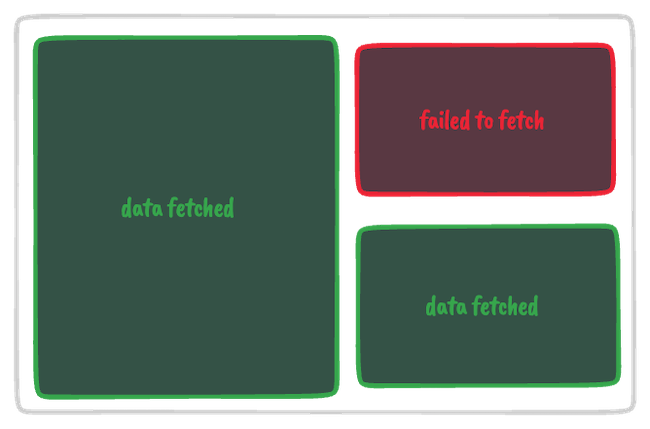Editor’s note: This article was updated on 3 August 2023 to compare data fetching with and without React Suspense.

Managing data loading in a frontend application can become complex over time, so much so that there is a whole ecosystem of libraries dedicated to state management. The React core team have responded by releasing a set of concurrent features to make data fetching in React easier. Suspense is among these features, and it aims to simplify managing loading states in React components.
In this article, we’ll look at how Suspense works by creating a simple app that fetches data from an API and renders it to the DOM. We’ll cover the following:
Suspense is a feature for managing asynchronous operations in a React app. It lets your components communicate to React that they are waiting for some data. It is important to note that Suspense is not a data fetching library like react-async, nor is it a way to manage state like Redux. It simply lets you render a fallback declaratively while a component is waiting for some asynchronous operation (i.e., a network request) to be completed.
As we’ll see further down, this allows us to synchronize loading states across different components to allow for a better user experience. Suspense does this in a non-intrusive way that doesn’t require a complete rewrite of existing applications.
Let’s look at the simplest use case of Suspense, which is handling a pending network request in a component:
const [todos, isLoading] = fetchData('/todos')
if (isLoading) {
return <Spinner />
}
return <Todos data={todos} />
This should look familiar, as it is how most people (me included) handle waiting for network calls. The implementation of the fetchData function, and the Spinner and Todos components is not relevant here.
The isLoading variable is used to track the status of the request. If true, we render a spinner to communicate this state to the user. There’s nothing wrong with doing it this way, but let’s see how we would handle this using Suspense:
const todos = fetchData('/todos')
return (
<Suspense fallback={<Spinner />}>
<Todos data={todos} />
</Suspense>
)
There’s a subtle but important change to the code. Instead of having the loading state as a state variable with logic to render a spinner based on the value, it’s instead being managed by React using Suspense. We’re now rendering a fallback declaratively.
In the previous example, React had no knowledge of the network call, so we had to manage the loading state using the isLoading variable. With this example, React knows that a network call is happening, and by wrapping the Todos component in Suspense, it delays rendering it until the network call is done.
Another important thing to note is the fallback property passed to Suspense. This is whatever we want to render while waiting for the network call to finish. It could be a spinner, skeleton loader, or nothing. React will render whatever the value of fallback is while waiting for the network request to finish.
But how exactly does React know that a network call is pending? As far as we’ve reviewed, Suspense only renders a fallback component while waiting. Where in the code do we communicate to React that we’re making a network call?
This is where the data fetching libraries come in. Currently, Relay and SWR have integrations with Suspense to communicate loading states to React. I imagine more library authors will add integrations in the future.
Now, let’s explore some common data fetching approaches, their limitations, and how Suspense improves the developer and user experience.
If a React component needs data from an API, we usually have to make a network request somewhere to retrieve it. This is where data fetching approaches come in to play.
Using the fetch-on-render approach, the network request is triggered in the component itself after mounting. The reason it’s called fetch-on-render is because the request isn’t triggered until the component renders:
const App = () => {
const [userDetails, setUserDetails] = useState({})
useEffect(() => {
fetchUserDetails().then(setUserDetails)
}, [])
if (!userDetails.id) return <p>Fetching user details...</p>
return (
<div className="app">
<h2>Simple Todo</h2>
<UserWelcome user={userDetails} />
<Todos />
</div>
)
}
A major drawback to this is that it can lead to a network waterfall problem. This is because every component has an async fetch request. If this component renders another component with similar fetch requests, it will result in multiple, nested waterfall-like requests that cause performance issues.
The fetch-then-render approach allows us to make an async request before the component is rendered. Let’s go back to the previous example and see how we would fix it:
const fetchDataPromise = fetchUserDetailsAndTodos() // We start fetching here
const App = () => {
const [userDetails, setUserDetails] = useState({})
const [todos, setTodos] = useState([])
useEffect(() => {
fetchDataPromise.then((data) => {
setUserDetails(data.userDetails)
setTodos(data.todos)
})
}, [])
return (
<div className="app">
<h2>Simple Todo</h2>
<UserWelcome user={userDetails} />
<Todos todos={todos} />
</div>
)
}
In this case, we’ve moved the fetching logic outside of the App component so that the network request begins before the component is even mounted.
Inspecting the networks tab clearly shows that both requests are started at the same time. While both fetchUserDetails and fetchTodos() are started in parallel, we would still need to wait for the slower request between the two to complete before we render any useful data. This is because Promise.all waits until all the promises are resolved before resolving.
We have seen how trivial data fetching patterns aren’t always very performant, and have issues when dealing with async calls. This is where we can tap into Suspense, which allows us to begin rendering our component immediately after triggering the network request. This particular data fetching pattern is called render-as-you-fetch.
As the name suggests, we are rendering UI consecutively as we fetch data from an API. This means that, just like fetch-then-render, we kick off fetching before rendering, but we don’t have to wait for a response before we start rendering. Let’s look at some code:
const data = fetchData() // this is not a promise (we'll implement something similar)
const App = () => (
<>
<Suspense fallback={<p>Fetching user details...</p>}>
<UserWelcome />
</Suspense>
<Suspense fallback={<p>Loading todos...</p>}>
<Todos />
</Suspense>
</>
)
const UserWelcome = () => {
const userDetails = data.userDetails.read()
// code to render welcome message
}
const Todos = () => {
const todos = data.todos.read()
// code to map and render todos
}
When App mounts for the first time, it tries to render UserWelcome first, and this triggers the data.userDetails.read() line. If the data isn’t ready yet (i.e., the request hasn’t resolved), it is communicated back to Suspense, which then renders <p>Fetching user details…</p>. The same thing happens for Todos.
The best thing about this pattern is that no component has to wait for others to finish, which improves response time.
While trivial client-side data fetching has existed in React for years, the new Suspense pattern is a good addition to the data fetching technique. From a user’s perspective, Suspense significantly improves data fetching because its subtle loaders not only provide immediate UI feedback, but also improve the CLS score by a large margin.
From the developer’s perspective, the Suspense pattern pushes for a more reactive pattern than a declarative one. We don’t need to manually handle errors, loading state for each async call from the app.
The Suspense API is becoming more popular as it allows for more reactive and maintainable code, resulting in better UX and performance. Now, let’s look at Suspense in a practical sense by building an app ourselves.
Using Suspense and the render-as-you-fetch approach, we will build a simple app that fetches data from an API and renders it to the DOM. I’m assuming you are already familiar with React Hooks. Check out the code for this project here.
This is what our app will look like:

First, let’s create all the files and folders and install the required packages. We’ll fill in the contents as we go. Then, to set up the project structure, run the following commands:
mkdir suspense-data-fetching && cd suspense-data-fetching
mkdir -p lib/{api,components} public
touch public/index.html public/index.css
cd lib/ && touch index.jsx
touch api/fetchData.js api/wrapPromise.js
cd components/
touch App.jsx UserWelcome.jsx Todos.jsx
Now, let’s install the required dependencies:
npm install react react-dom npm install --save-dev parcel parcel-bundler
We’re installing parcel and parcel-bundler to help us transpile our code into something that the browser can understand. The reason I opted for Parcel instead of something like webpack is because it requires zero config and works really well.
Next, add the following section in package.json:
"scripts": {
"dev": "parcel public/index.html -p 4000"
},
Now that we have our project structure ready and the required dependencies installed, let’s start writing some code. To keep the tutorial succinct, I will leave out the code for the following files, which you can get from the linked repo: index.html and index.css.
Now, we can create our API folder where we will be writing most of our logic. In this folder, there will be two files. The first is wrapPromise.js, which is simply a wrapper for handling various Promise states. The second file is fetchData.js where we will fetch from an actual URL endpoint.
wrapPromise.jsThis is probably the most important part of this whole tutorial because wrapPromise.js is what communicates with Suspense, and what any library author writing abstractions for the Suspense API would spend most of their time on.
wrapPromise.js is a wrapper that wraps over a Promise and provides a method that allows you to determine whether the data being returned from the Promise is ready to be read. If the Promise resolves, it returns the resolved data. If it rejects, it throws the error. And if it is still pending, it throws back the Promise.
This Promise argument is usually going to be a network request to retrieve some data from an API, but it could technically be any Promise object. The actual implementation is left for whoever is implementing it to figure out, so you could probably find other ways to do it.
The wrapPromise.js function has the following requirements:
With the requirements defined, it’s time to write some code. Open the api/wrapPromise.js file and we can get started:
function wrapPromise(promise) {
let status = 'pending'
let response
const suspender = promise.then(
(res) => {
status = 'success'
response = res
},
(err) => {
status = 'error'
response = err
},
)
...to be continued...
What’s happening here? Inside the wrapPromise.js function, we’re defining two variables:
status: Tracks the status of the promise argumentresponse: Holds the result of the Promise (whether resolved or rejected)status is initialized to pending by default, because that’s the default state of any new Promise. We then initialize a new variable, suspender, set its value to the Promise, and attach a then method to it.
Inside this then method, we have two callback functions: the first to handle the resolved value, and the second to handle the rejected value. If the Promise resolves successfully, we update the status variable to be success and set the response variable to the resolved value. If the Promise rejects, we update the status variable to be error and set the response variable to the rejected value:
...continued from above...
const read = () => {
switch (status) {
case 'pending':
throw suspender
case 'error':
throw response
default:
return response
}
}
return { read }
}
export default wrapPromise
Next, we create a new function called read, and inside this function, we have a switch statement that checks the value of the status variable. If the status of the promise is pending, we throw the suspender variable we just defined. If it is error, we throw the response variable. And, finally, if it is anything other than the two (i.e., success), we return the response variable.
The reason we throw either the suspender variable or the error response variable is because we want to communicate back to Suspense that the Promise is not yet resolved. We’re doing that by simulating an error in the component (using throw), which will be intercepted by the Suspense component. The Suspense component then looks at the thrown value to determine if it’s an actual error or a Promise.
If it is a Promise, the Suspense component will recognize that the component is still waiting for some data, and it will render the fallback. If it’s an error, it bubbles the error back up to the nearest error boundary until it is either caught or it crashes the application.
At the end of the wrapPromise.js function, we return an object containing the read function as a method, and this is what our React components will interact with to retrieve the value of the Promise.
Lastly, we have a default export so that we can use the wrapPromise.js function in other files. Now let’s move on to the fetchData.js file.
fetchData.jsInside this file, we’ll create a function to fetch the data that our components require. It will return a Promise wrapped with the wrapPromise.js function we just reviewed:
import wrapPromise from './wrapPromise'
function fetchData(url) {
const promise = fetch(url)
.then((res) => res.json())
.then((res) => res.data)
return wrapPromise(promise)
}
export default fetchData
The first thing we do here is import the wrapPromise function we created, and then define the fetchData function.
Inside this function, we initialize a new variable, promise, and set its value to a fetch request Promise. When this request is completed, we get the data from the Response object using res.json() and then return res.data, which contains the data that we need.
Finally, we pass this promise to the wrapPromise function and return it. At the end of this file, we export the fetchData function. Now on to the components!
We now have the “backend” for our app ready, so it’s time to build out the components.
index.jsxindex.jsx is the entry point of our application, and we’ll be creating it first. This is where we’ll mount our React app to the DOM:
import React from 'react'
import ReactDOM from 'react-dom/client'
import App from './components/App'
const mountNode = document.querySelector('#root')
ReactDOM.createRoot(mountNode).render(<App />)
Notice, we are using React 18, which means that the new createRoot API is being used.
App.jsxThis is where we will import and use the majority of our components, wrapped in Suspense API. Here, we have used Suspense’s fallback for nearly every component that is supposed to fetch or deal with an asynchronous operation:
import React, { Suspense } from 'react'
import UserWelcome from './UserWelcome'
import Todos from './Todos'
const App = () => {
return (
<div className="app">
<h2>Simple Todo</h2>
<Suspense fallback={<p>Loading user details...</p>}>
<UserWelcome />
</Suspense>
<Suspense fallback={<p>Loading Todos...</p>}>
<Todos />
</Suspense>
</div>
)
}
export default App
UserWelcome.jsxUserWelcome.jsx is a component that renders username. Alternatively, you could have included this in App.jsx itself but for the sake of clean code, you can also modularize it:
import React from 'react'
import fetchData from '../api/fetchData'
const resource = fetchData(
'https://run.mocky.io/v3/d6ac91ac-6dab-4ff0-a08e-9348d7deed51'
)
const UserWelcome = () => {
const userDetails = resource.read()
return (
<div>
<p>
Welcome <span className="user-name">{userDetails.name}</span>, here are
your Todos for today
</p>
<small>Completed todos have a line through them</small>
</div>
)
}
export default UserWelcome
Todos.jsxThis component reads todos and renders them on the UI:
import React from 'react'
import fetchData from '../api/fetchData'
const resource = fetchData(
'https://run.mocky.io/v3/8a33e687-bc2f-41ea-b23d-3bc2fb452ead'
)
const Todos = () => {
const todos = resource.read()
const renderTodos = todos.map((todo) => {
const className = todo.status === 'Completed' ? 'todo-completed' : 'todo'
return (
<li className={`todo ${className}`} key={todo.id}>
{todo.title}
</li>
)
})
return (
<div>
<h3>Todos</h3>
<ol className="todos">{renderTodos}</ol>
</div>
)
}
export default Todos
Now that all our React components are in place, let’s look at how to manage rendering order with Suspense.
Imagine if the Todos component gets its data first, and you begin to go through the list only for UserWelcome to resolve a little while later. The new contents being rendered will push the existing todo contents down in an awkward way, and this could disorient your users:

If you want the Todos component to render only when the UserWelcome component has finished rendering, then you could nest the Suspense component wrapping Todos like so:
<Suspense fallback={<p>Loading user details...</p>}>
<UserWelcome />
<Suspense fallback={<p>Loading Todos...</p>}>
<Todos />
</Suspense>
</Suspense>
Another approach is to wrap both Suspense components in SuspenseList and specify a “reveal order,” like so:
<SuspenseList revealOrder="forwards">
<Suspense fallback={<p>Loading user details...</p>}>
<UserWelcome />
</Suspense>
<Suspense fallback={<p>Loading Todos...</p>}>
<Todos />
</Suspense>
</SuspenseList>
This will cause React to render the components in the order they appear in your code, regardless of which one gets its data first:

You can see how easy it becomes to organize your application’s loading states as opposed to having to manage isLoading variables yourself. A top-down loading style is much better.
We can even go a step further and add error handling capabilities to our application. Suspense provides an intuitive API to handle errors: Error Boundary. This API helps catch errors within the Suspense tree without affecting the rest of the React DOM nodes.
In a typical Suspense pattern, we are likely running an async operation using Promises. This Promise might not be resolved, and the Suspense boundary needs to take care of this scenario as well. This is where Error Boundary comes in to take care of a failed Promise state.
To use Suspense effectively, we need to use Error Boundary. The official React docs provide an Error Boundary component that you can simply import in your component:
class ErrorBoundary extends React.Component {
constructor(props) {
super(props);
this.state = { hasError: false };
}
static defaultProps = {
fallback: <h1>Something went wrong.</h1>,
};
static getDerivedStateFromError(error) {
return { hasError: true };
}
componentDidCatch(error, errorInfo) {
console.log(error, errorInfo);
}
render() {
if (this.state.hasError) {
return this.props.fallback;
}
return this.props.children;
}
}
Now we are all set to use this component within the Suspense boundary:
import ErrorBoundary from "./errorboundary";
<ErrorBoundary fallback={<div>Failed to fetch data!</div>}>
<Suspense fallback={<h3>Loading...</h3>}>
// root component of our application
<App />
</Suspense>
</ErrorBoundary>
Notice how the entire app is wrapped in an ErrorBoundary component. This ensures a root-level error that will stop your entire app from rendering if the Promise fails.
There may be certain use cases where you want a global error boundary like we see above, such as when there is an internet connection interruption and you want to stop the entire to-do app.
However, in most cases, you want to delegate the error boundary close to each component only. This allows you to have component-wise error handling that doesn’t stop the entire app altogether or affect other DOM nodes from their usual operations:

We’re done coding our components, and it’s time to review what we’ve done so far:
index.jsx fileApp component that had two children components, each wrapped in a Suspense componentLet’s run our app and see if it works. In your terminal, run npm run dev and navigate to http://localhost:4000 in your browser. Open the Networks tab in your Chrome developer tools and refresh the page. You should see that the requests for both the completed and pending todo items are both happening in parallel like so:

If we look at the Waterfall section, we can see that we have successfully implemented a naive version of Suspense for data fetching. You can see how it helps you orchestrate your app’s data fetching operations in a simple and predictable manner.
In this article, we took a look at the React Suspense component, and various data fetching approaches in React. We also built a simple app that uses Suspense for data fetching.
The newly built React docs are a great resource for learning about data fetching from the server point of view, but for client-heavy interactions, you can always opt for the fetching patterns we discussed above.
Install LogRocket via npm or script tag. LogRocket.init() must be called client-side, not
server-side
$ npm i --save logrocket
// Code:
import LogRocket from 'logrocket';
LogRocket.init('app/id');
// Add to your HTML:
<script src="https://cdn.lr-ingest.com/LogRocket.min.js"></script>
<script>window.LogRocket && window.LogRocket.init('app/id');</script>
Would you be interested in joining LogRocket's developer community?
Join LogRocket’s Content Advisory Board. You’ll help inform the type of content we create and get access to exclusive meetups, social accreditation, and swag.
Sign up now
Explore the key differences between Angular and React, their strengths, and use cases to help developers decide which option to choose.

GET, POST, PUT and DELETE requestsLearn how to use Axios in JavaScript for GET, POST, PUT & DELETE requests. Examine setup, error handling, and API best practices.

AI for 3D web development is taking the internet by storm. Learn about this trend, the best tools for 3D web experiences, and how it’ll affect the development landscape moving forward.

exit code 1 in Dockerexit code 1 is one of the most common and frustrating errors for developers working in Docker. Explore what it means and how to fix it.
6 Replies to "Data fetching with React Suspense"
While the hack is interesting (kudos for that)… It surely breaks the separation of concerns paradigm.
Could you explain a bit more? What separations are being broken by Suspense?
Hey Ovie, great article!
I was just wondering if you’d know how to convert the `wrapPromise` helper to the async/await syntax? I’ve been trying to do it but I’m not sure what to throw when the status is “pending”.
Hey nice article, thanks. Nice trick the wrapPromise function. I haven’t tried yet. Thanks again and congratulations.
i found this didnt work by assigning wrapPromise.status and wrapPromise.response as local variables because state was not retained between subsequent calls to wrapPromise.read(). This worked fine for me when I moved status and response to global scope.
Good stuff. I’m curious where you got the API for creating Suspense enabled data fetching functions. I can’t see it in the React documents.